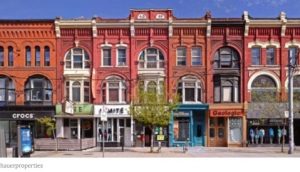Fish Out of Water: Deconstructing Branding through Urban Crawls
Fish Out of Water: Deconstructing Branding
by Carol Arcus
The following is an outline of a field study I have done with Grade 11 Media Studies students. They always loved doing it, and learned a great deal. The world never looks the same again.
This is easily adapted to any urban-type environment.
Students visit several high-profile stores on this trip to downtown Toronto, including the Nike flagship store on Bloor Street. They make detailed notes on the Nike store, plus two other stores: a total of 3 stores.
They are asked to be as objective as possible. In other words, try not to let their personal tastes get in the way of their observations.
Some suggestions for visits: Body Shop, Roots, Williams Sonoma, Pottery Barn, HMV, FCUK. Indigo, Club Monaco, Banana Republic, Benetton, Holt Renfrew, Chanel, Eddie Bauer, MAC, Aveda, Ashley’s (all on Bloor between Yonge and Avenue Road) or any high-profile store in the Bay/Bloor area.
SECTION A
For EACH of the 3 stores, they answer the following:
1. Choose 4 elements from the list below, that contribute most effectively to the branding of the target consumer:
a) window display: positions of, and types of, mannequins (anything outstanding or original?); clothing (how does it represent the company’s image?); other (colour, other objects – anything worth noting?) how does the overall window reflect the image of the company?
b) architectural elements: use of colour; use of light; number of floors; use of materials (wood, metal, leather, rubber, plastic, glass, etc); line (straight lines, curves, angles, circles, etc); objects (furniture; flowers, accessories, etc); layout (stairways, aisles, rack placement, cash desk placement, changing rooms, etc). Explain effects of the most effective elements. can you match a taste or lifestyle to this design? (eg, outdoorsy? ultramodern? basic? environmentally correct? cutting edge, etc?) can you match a ‘feeling’ to this design? (eg, warm, cool, exciting, airy, comforting, etc?)
c) use of visual media (photos, logos, film & video, written text, other graphics). Effect(s)?
d) placement & display of merchandise (neatly folded & matched by colour?; hung and matched by style?; matched by size?, matched by purpose? easily accessible or hard to reach? attractively displayed on mannequins? what merchandise is placed at the entrance, as opposed to that which is placed at the farthest end of the store? gender split?, etc). Effect(s)?
e) amount of, and placement of, empty space. What is the effect of this?
f) music: what music, if any, is being played in the store? What feelings or lifestyle does it evoke? Can you link this choice of music to the target consumer?
g) interactive elements: way(s) that you are encouraged to become part of the culture of this company. These are activities – hands-on experiences – which invite you to be part of their Community.
h) sales associates: does their appearance relate with the overall environment? is their attitude an appropriate part of the ‘culture’ of this store, and does it encourage consumer participation?
i) anything significant here that is NOT on the list?
2. For each store, they also answer:
a) clothing/merchandise: briefly describe. For what purposes does this merchandise appear to be designed? Is it being used for any other purposes by its buyers?
b) targeted consumer: try to describe the average consumer of this store, based on all the above observations. Include age, income, lifestyle, musical tastes, gender, race, religion
c) summing up (4 or 5 sentences): How has the total environment been designed to brand the target consumer? Include a brief explanation of the ways it has done these things. In other words, how has the environment been constructed to seamlessly integrate itself into the popular culture tastes and lifestyles of the buyers?
Summary questions:
Choose two below, plus # 7 (total of 3 questions).
1. Compare 2 stores you visited today, in terms of overall environment, clothing style, and attitude. How do the differences in environment reflect the differences in target market? Which was more successful in branding its customers?
2. In what respect are we entering a “whole environment” when we enter a high-profile clothing store? In what respect do we become part of a community when we enter a high-profile clothing store? In what respect are we entering an ad when we enter a high-profile clothing store?
3. Consider the physical proportion of the merchandise itself to the other environmental elements (noted above). Which environmental element, or combination of elements, actually ‘sells’ the merchandise? Explain why environment would be as significant as merchandise.
4. As a neutral observer, explain the ‘environment store’ phenomenon. Why would our market culture need to provide ‘environments’ to its potential consumers, as opposed to just hanging out the merchandise?
5. What store most appealed to you, personally? Explain why. Did you buy anything at this store today, or make a plan to buy something there in the future? If so, is there any element in the store environment that might have contributed to this decision? (be honest) How do you, as an individual, ‘fit’ the store’s clothing and attitude? (Use your notes to help you).
6. Youth culture includes music, lifestyle (various leisure activities), TV and film tastes, and clothing tastes, among other things. How much of this culture is made by youth themselves, for themselves, and how much is marketed and sold to them by corporations? In other words, what is the relationship between the culture that youth have constructed for themselves, and the culture that has been constructed by others to keep them consuming? Do youth have strategies of behaving like consumers, while at the same time staying independent of persuasive marketing and creating their own culture?
7. ** In 300 words, reflect on the following quote from Phil Knight (NIKE), using evidence from Wednesday’s experience: “One of the effects of branding is to make you feel as if you are part of a community.”
SECTION B.
Students then move to the Eaton Centre on Dundas Street in Toronto, where they complete the following:
Eaton Centre Visit: Re-read the article, “The Malling of Main Street”. (see the media textbook, Mass Media and Popular Culture, by Barry Duncan, Janine D’Ippolito, Cam MacPherson, and Carolyn Wilson)
Choose 3 characteristics of malls from this article, and explain below how the Eaton Centre illustrates, or contrasts with, those characteristics.
(These lesson ideas are adaptable to both elementary and secondary school classrooms – ed.)




